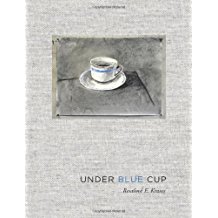Under Blue Cup, Rosalind Krauss, 2011
After re-discovering Krauss through Janet Malcolm’s wonderful essay about the Girl and the Zeitgeist, I found that Krauss is still a professor of art history at Columbia and had written this recent book. Under Blue Cup was one of the phrases that was used to test Krauss’s memory after a devastating cerebral aneurysm rupture several years ago which left her in a prolonged coma and with major deficits in memory, spatial sensation, and speech. Her remarkable recovery led to this combination memoir (‘the aneuryst’) and critical evaluation of installation art, a mode which she despises. Krauss, often writing in totally incomprehensible sentences, gives an overview of post-modernist and post-medium art of the last 20 years. Drawing upon Barthes (‘Zero Degree’s ‘pleasure of the text’ in lingering over the signifier and its vertical beauty in the horizontal narrative), Dickens’ Bleak House, Sontag’s erotics of art, Cavill’s automatism, and Benjamin (‘the system of aesthetic production of any given age will control the manner in which human sense perception is organized’), Krauss focuses on the critical question of ‘who you are’ both for her post-aneurysm self and for all artists caught up in analogy and succession. She focuses on eight artists (knights in her analogy with the chessboard, diagonal movement, white to black change, and jumping over) in her discussion of the technical medium providing the ‘sides of the pool’ to push off. These 8 develop new technical supports as medium which undergirds the very possibility of art and stand in contrast to the kitsch of performance and installation art embodied in Kassel’s Documenta X exhibit of 1997 which attempted to finally kill the ‘white cube’. Ed Ruscha (automobiles), William Kentridge (animation and erasure), James Coleman (the still film frame), Christian Marclay (synchronous sound and film), Bruce Nauman (architectural trope of the promenade and video’s specific surveillance), Marcel Broodthauer (the art book), and Harim Farocki (video editing) are her heroes, developing rules that enable a medium that provides for both a historical perspective and future progress in pushing off the sides of the white cube pool. For Krauss in her post-aneurysm life, memory, medium, historical context, and meaning are all important and are placed in opposition to the false corruption of taste by kitsch. This was a very difficult book but important for further understanding contemporary art. Next are Clement Greenberg and Michael Fried!



